Application, distribution, frequency, calculations and adjustment practices are all very important
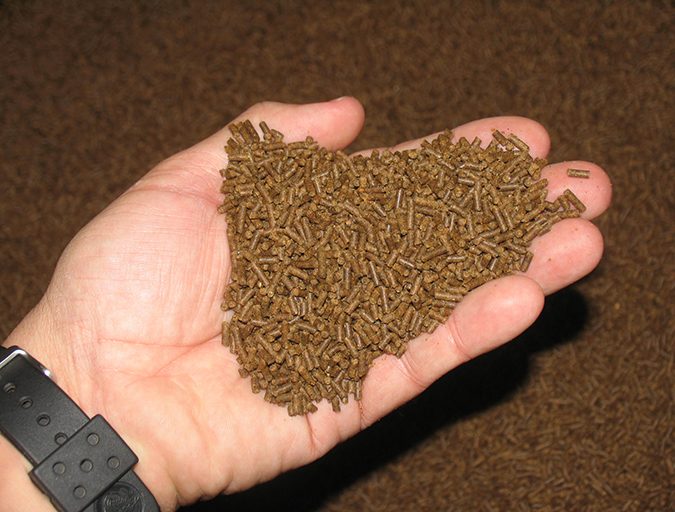
Application and distribution of aquafeed
Shrimp aquafeeds are typically applied by manual broadcasting from levees or from boats moving through the pond by rowing or using gasoline engines, or mechanically using feed blowers mounted on vehicles or towed along levees and also from boats. Even crop-dusting airplanes were used many years ago to distribute feed to very large (> 20 hectare) ponds.
In smaller (< 1 ha), more intensive (higher stocking density) ponds, tanks and raceways, automatic feeders with timing mechanisms can be used. Automatic feeders are a useful alternative to manual feed broadcasting, but should not replace regular observation and visual assessment by trained personnel. The use of feed trays to apply all aquafeed in a pond was very popular in various countries some years ago, but this practice is relatively rare today.
Manual feeding has various advantages, including: even and efficient distribution of feed in ponds of any size and location; reduced competition for feed among shrimp, which remain more widely distributed throughout the pond; and wind and rain do not interfere with hand feeding as much as they do with mechanical feeding. Some disadvantages include: supervision is required; fuel and labor costs are higher than they are for mechanical feeding; and biosecurity more problematic as equipment and personnel move from one pond to the next.
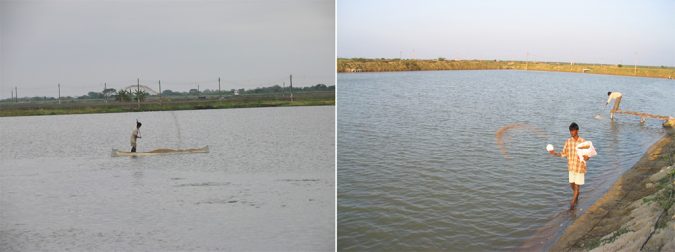
In general, the advantages of mechanical feeding include: the ability to feed many ponds with very few workers; more competitive costs for mechanical feeders; more flexibility for feeding times, while feeding logistics can be optimized with a mechanical feeder; feeders can be towed along the levees; and in some cases, fuel costs can be lower than for manual feeding.
Disadvantages: farm roads or levees must be in good condition to allow vehicle transit; pond dimensions may affect feeding efficiency; and wind may restrict feeding to only some sides of the pond; feed may randomly concentrate in certain areas, causing areas of high organic loading and water quality problems. And during rainy periods, some roads and levees can become too slippery for the transit of trucks and mechanical feeders.
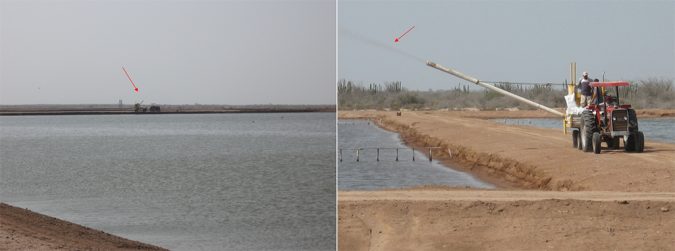
Early in the grow-out cycle it is important to distribute the feed evenly throughout the pond. At many farms with larger (< 3-4 ha) ponds, feeding is done from boats that follow established patterns usually marked throughout the pond. But as the cycle progresses managers must be aware that shrimp will react to changing microhabitat variability in the pond, both in space and time.
Animals will avoid areas where anaerobic sediments accumulate and noxious compounds such as hydrogen sulfide are present. These areas include internal drainage canals and areas close to the drainage structures. This is more relevant towards the end of the growout cycle, when considerable waste will have accumulated in these deposition areas due to the large amounts of feed already applied.
In addition, many shrimp will move to deeper areas within a pond during the day to avoid light. Therefore, very shallow areas or those with anaerobic sediments should not receive any feed during daylight hours, because it is unlikely shrimp will consume it. However, it is also important to consider that shrimp distribution in ponds is generally not uniform, and that several factors can influence how animals distribute themselves in ponds. These and other considerations must be taken into account when distributing feed in ponds
Automatic feeders like the one shown below are gaining popularity in several of the major shrimp farming countries in Asia. At this time their use is relatively limited elsewhere. Some of the benefits reported from these auto-feeders include a significant reduction in feed conversion ratio (FCR), improved average daily growth, more uniform shrimp size, less physical damage to shrimp shells, improved pond water quality and reduced labor required to feed the ponds.
More recently, commercial systems that distribute feed automatically in response to shrimp feeding activity by using computerized systems and underwater microphones, have entered the industry.

Feeding frequency and timetables
All formulated aquafeeds have an ideal feeding rate range that optimizes growth and feed efficiency. This range varies depending on species, animal age and weight, density, water quality, availability of natural foods, stress and other factors.
At many farms, feeding is based on tables that do not properly consider natural feeding habits of shrimp or their physiological state. Increasing the frequency of feeding generally produces immediate benefits, including reduced nutrient and feed loss, and increased growth and feed utilization efficiency. In Asia, it is typical to feed several times, while most shrimp farms in Latin America feed one to three times, usually between the morning and late afternoon. The optimal number of times to feed penaeid shrimp species over a 24-hour period remains an unresolved subject, largely dependent on the particular experience of each farm manager and on available resources. Many penaeids spend the day buried in the bottom and emerge at night to forage and feed, but there is also evidence for the opposite.
One argument for higher feeding activity at night is that in some penaeid species the production of digestive enzymes peaks a few hours after nightfall. Some research indicates that day‑time feeding for Pacific white shrimp (Litopenaeus vannamei) is as good as – and possibly preferable to – night feeding, and that increasing feeding frequency significantly affects growth in this species. Other research that investigated seasonal changes in feeding behavior reported that shrimp fed at night (during the dry season) grew more than 60 percent faster than shrimp fed during daylight hours.
Regardless, the foregut of penaeid shrimp has a small volume; consequently, animals must essentially feed continuously to obtain enough food. In general, penaeid shrimp appear to feed continuously and empty their guts within four hours after a full meal is ingested. Distributing the daily ration in multiple feedings a few hours apart normally improves feed conversion and growth, and reduces accumulation of uneaten feed and pond water and bottom deterioration.
How many times and when to feed is an important decision that each shrimp production facility must evaluate and determine, based on experience, season and changing environmental conditions, species and stocking densities, production system used, available resources and other considerations. Feeding during the night can become more important as the production cycle progresses and the availability of natural feed diminishes. In general, a minimum of two feedings per day should be implemented at the beginning of the production cycle, and increased as the cycle progresses to at least three to four times during the last month or so.

Calculation and adjustment of rations
Early on, feed rations were calculated based on a set schedule that depended on animal weight and estimated biomass/survival in the pond. Feeding based on tables is still widely practiced. These tables can vary by species, geographic area, age of animals, target mean size, intensity level of culture, water temperature and dissolved oxygen, feed attractability and water stability, frequency and times of feeding, and other factors.
Daily ration is calculated based on estimates of density, mean individual weight of animals and survival percent, and percent body weight to feed daily. Each farm can develop its own in‑house survival and feeding tables over time. Feeding tables are available from most commercial aquafeed manufacturers.
The major drawback of these feed calculations is the difficulty of accurately estimating survival rates, particularly when dealing with small animals in large (< 5 ha) ponds. Several factors affect feeding rates, including poor water quality (low dissolved oxygen levels, temperature extremes, sudden pH fluctuations, increasing concentration of toxic gasses from decaying bottom conditions) plankton population changes and molting cycles. Feed consumption changes due to these as well as other stressors can usually be detected by the proper monitoring of feed trays, which have become very important in feed management in shrimp culture.
Feeding rates are adjusted based on population sampling and monitoring of environmental parameters such as water temperature, dissolved oxygen and other water parameters, the use of feed trays and experience. Rates are adjusted periodically (usually weekly) based on sampling estimates for individual average body weight, population size distribution and pond shrimp biomass. As animals grow the feed amounts used decrease as a percentage of the total shrimp biomass, but the total amount of feed increases proportionally with increasing shrimp biomass.
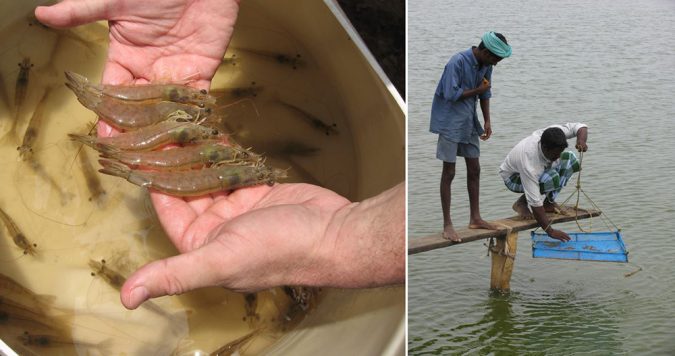
Routine sampling is common in most farms to monitor shrimp populations and overall health of animals in ponds. Sampling is generally carried out by collecting samples using cast nets with net apertures about 0.5‑1.0 centimeters, cast from boats or the pond dikes. Personnel new to the sampling procedure must be closely supervised initially, when they tend to bring back the largest animals instead of collecting a random sample.
In areas subject to wide variations in tidal magnitude due to lunar/tidal cycles, shrimp commonly behave differently during spring and neap tides. Typically, shrimp population sampling is done once per week or every two weeks, and estimates of population size and survival rates can be remarkably inaccurate for several reasons, including shrimp activity (molting, lunar/tidal cycle), and human error and/or negligence. It is important for a farm to establish in-house sampling methods to quickly and accurately estimate shrimp population size.
References available from author.
Author
-

Darryl E. Jory, Ph.D.
Editor Emeritus
Global Aquaculture Alliance[103,114,111,46,101,99,110,97,105,108,108,97,97,103,64,121,114,111,106,46,108,121,114,114,97,100]
Related Posts
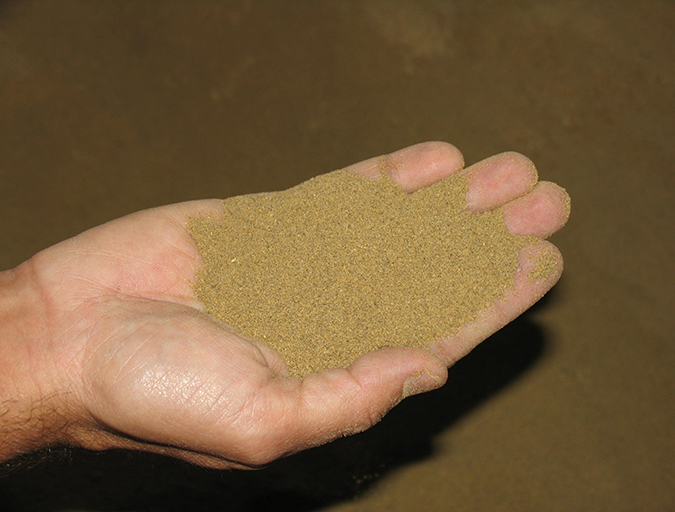
Aquafeeds
A look at the SME controlled extrusion process
A study was conducted using a Twin-Screw Extruder equipped with Specific Mechanical Energy (SME) and Density Control valves, to determine the effect of SME on the water stability of shrimp feeds. Further research is needed to evaluate the performance.

Aquafeeds
Shrimp feeds depend on proper ingredient grinding
The proper feed particle sizes of aquafeed ingredients are established by the nutritional requirements of the species targeted and by the feed manufacturing process used. For proper ingredient particle sizes, various characteristics are very important, including particle size distribution and pellet density.
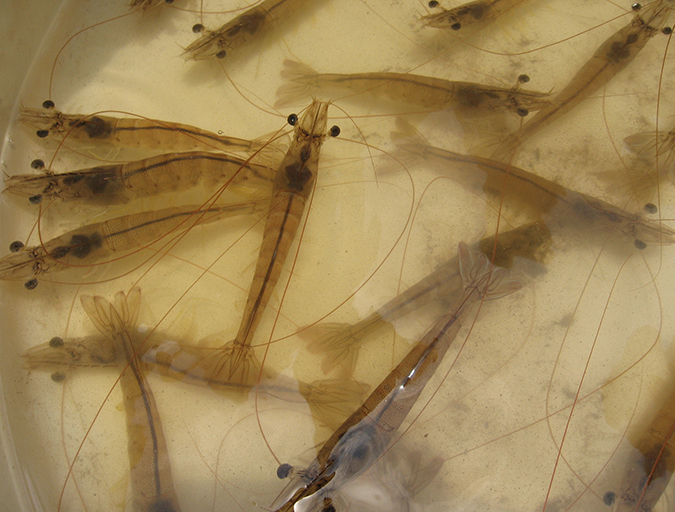
Aquafeeds
The digestibility of hydrolyzed soy protein
Studies demonstrate that hydrolyzed soy protein can be well digested and utilized by Pacific white shrimp, and that digestibility is improved through a bioprocess with the bacterium Lactobacillus spp.
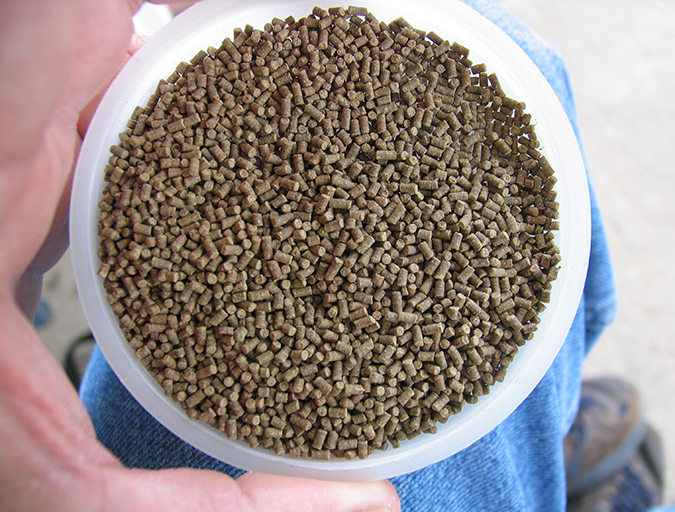
Aquafeeds
The proper management of commercial shrimp feeds, part 1
Shrimp production systems and their feed management must be considered together. It requires an understanding of biological aspects of the targeted species and age, of production system used, of chemical and biological processes that control water and bottom quality and continuous system monitoring and feedback to provide appropriate and timely inputs and adjustments.

